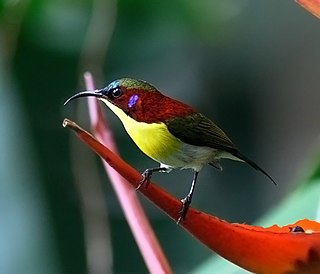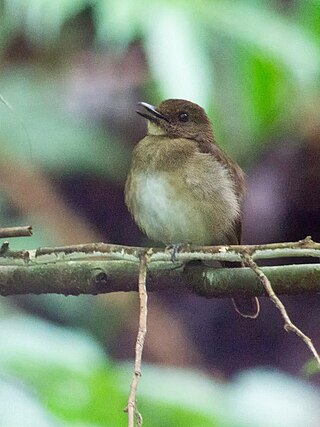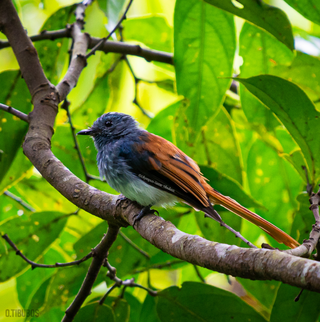
The handsome sunbird is a species of bird in the family Nectariniidae. It is endemic to the Philippines.

The white-winged cuckooshrike, also known as white-winged cicadabird or white-winged graybird, is a species of bird in the family Campephagidae. It is endemic to the Philippines found on the islands of Negros, Panay and formerly on Guimaras. Some taxonomists place this species in the genus Analisoma.

The striped flowerpecker is a species of bird in the family Dicaeidae. It is endemic to the Philippines. Its natural habitats are tropical moist lowland forest and tropical moist montane forest. It is part of the Thick-billed flowerpecker species complex and was formerly conspecific with it.

The yellow-crowned flowerpecker is a species of bird in the family Dicaeidae. It is endemic to Luzon Island in the Philippines. It was formerly conspecific with the Flame-crowned flowerpecker of Mindanao. Its natural habitat is tropical moist montane forest. It is becoming rare due to habitat loss.

The black-belted flowerpecker or Visayan flowerpecker, is a species of bird in the family Dicaeidae. It is endemic to the Philippines where it is restricted to Panay, Negros and Guimaras islands. It was formerly regarded as a subspecies of the more widespread red-keeled flowerpecker. Sometimes the name red-keeled flowerpecker is used for D. haematostictum and D. australe is then known as the red-sided flowerpecker.

The buzzing flowerpecker or white-bellied flowerpecker is a species of bird in the family Dicaeidae. It is endemic to the Philippines. Its natural habitats are tropical moist lowland forest and or tropical moist montane forest.

The olive-capped flowerpecker is a species of bird in the family Dicaeidae. It is endemic to the island of Mindanao in the Philippines.Its natural habitat is tropical moist montane forest.

The whiskered flowerpecker is a species of bird in the family Dicaeidae. It is endemic to the island of Mindanao in the Philippines. Its natural habitat is tropical moist montane forest. It is becoming rare due to habitat loss.

The pygmy flowerpecker is a species of bird in the family Dicaeidae. It is endemic to the Philippines.

The scarlet-collared flowerpecker is a species of bird in the family Dicaeidae, about 10cm long and is endemic to the Philippines where it found only in the tropical moist lowland forests in Mindoro, usually occurring below 1000m in the canopy and edge of the forest and in open country with scattered trees. Along with the critically endangered Cebu flowerpecker, it is one of the two threatened flowerpeckers in the Philippines and is declining primarily due to habitat loss.

The Mindanao white-eye, also known as the black-masked white-eye, is a species of bird in the family Zosteropidae. The specific epithet honours British zoological collector Walter Goodfellow. It is endemic to the Philippines. Its natural habitat is subtropical or tropical moist montane forest.

The melodious babbler is a species of bird in the family Pellorneidae. It is endemic to the Philippines and found only on Palawan and Balabac.

The Palawan flowerpecker is a species of bird in the family Dicaeidae. It is endemic to the Philippines found only in the Palawan island group. Its natural habitat is tropical moist lowland forest.

The white-throated jungle flycatcher, also known as the Negros jungle flycatcher is a species of bird in the Old World flycatcher family Muscicapidae. It is endemic to the Philippines and formerly on Guimaras before its extirpation there. The natural habitats of the white-throated jungle flycatcher are tropical moist lowland forests and tropical moist montane forests at altitudes of up to 1,350 meters. It is threatened by habitat loss.

The sulphur-billed nuthatch is a species of bird in the family Sittidae. It is endemic to the Philippines. Its natural habitats are tropical moist lowland forest and tropical moist montane forest. It is commonly found in mixed flocks along with Blue-headed fantails, sunbirds, flowerpeckers and other small forest birds.

The rusty-crowned babbler is a species of bird in the family Zosteropidae. It is native to the southern Philippines on the islands of Mindanao and Dinagat Islands and Basilan. Its natural habitat is tropical moist lowland forest.

The Mindanao pygmy babbler is a bird species endemic to the Philippines. It had been placed in the family Timaliidae, but it is a close relative of the white-eyes, however, and many taxonomists now place it in the family Zosteropidae..

The Visayan fantail is a fantail endemic to the Philippines on islands of Negros, Panay, Guimaras, Masbate and Ticao. Until recently, it was considered conspecific with the blue-headed fantail and Tablas fantail.

The flame-crowned flowerpecker is a species of bird in the family Dicaeidae. It is endemic to Mindanao in the Philippines. The yellow-crowned flowerpecker, which is endemic to Luzon, was formerly considered conspecific.

The fire-throated flowerpecker is a species of bird in the flowerpecker family Dicaeidae that is found in the Philippines except on the islands of Mindoro, the Palawan group and the Sulu Archipelago. It was formerly considered to be a subspecies of the fire-breasted flowerpecker.






















